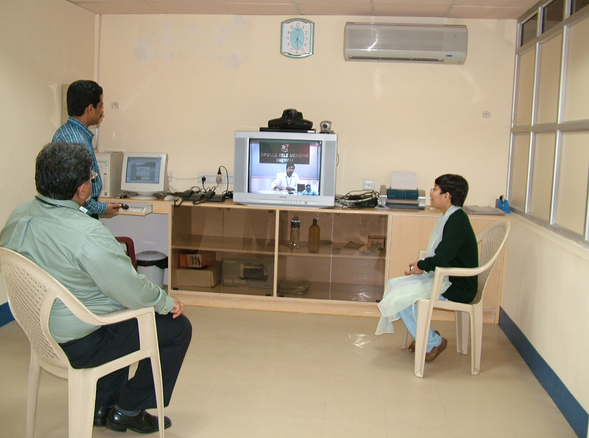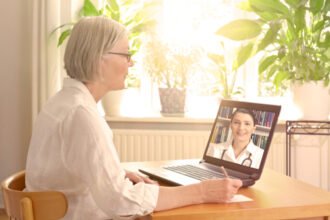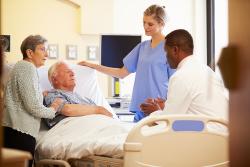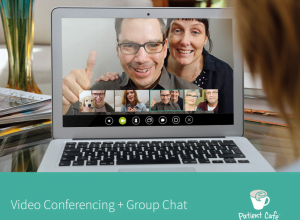EXCLUSIVE POST, CO-AUTHORED WITH DR GARY LEVIN – In a developing country such as India, telemedicine can have a huge impact. Since about 75% of Indians live in remote rural areas and more than 75% of doctors live in cities, there is a large discrepancy in healthcare distribution.
EXCLUSIVE POST, CO-AUTHORED WITH DR GARY LEVIN – In a developing country such as India, telemedicine can have a huge impact. Since about 75% of Indians live in remote rural areas and more than 75% of doctors live in cities, there is a large discrepancy in healthcare distribution. The Indian government, with the help of the Indian Space Research Organization (ISRO) has connected rural hospitals with city-based specialty hospitals through their GSAT satellites This network allows those in rural areas to have access to healthcare professionals and specialists. It also allows for mobile telemedicine units in remote villages.

A telemedicine program in action at the Apollo Gleneagles Hospital, Kolkata, India (photo:Nimoni Debnath/Apollo Gleneagles Hospital)
A typical small health center telemedicine system includes a computer, software, and several medical devices (EKG, X-ray or scanner). Images and test results can then be sent to specialist doctors who can interpret the results and suggest treatment through video-conferencing.
In regards to India’s telemedicine initiative, L.S. Sathyamurthy, Vice President of Telemedicine at ISRO, said,
“There are 650 district hospitals, 3,000 taluk [subdistrict] hospitals, and more than 23,000 primary health centers in the country. We must aim to connect all these in phases—first the district hospital connected to speciality hospitals in major cities, then the taluk-level hospitals, and finally the primary health centers, so that nobody, irrespective of his location, is deprived of lifesaving specialty consultation.”
Although there are many challenges to the system, including the cost of initial investment, user intimidation by technology, and technical difficulties, most people involved in the program believe that they can be overcome. The potential of the telemedicine initiative is huge. Dr. Devi Shetty sums it up well by saying,
“In terms of disease management, there is [a] 99% possibility that the person who is unwell does not require [an] operation. If you don’t operate you don’t need to touch the patient. And if you don’t need to touch the patient, you don’t need to be there. You can be anywhere, since the decision on healthcare management is based on history and interpretation of images and chemistry … so technically speaking, 99% of health-care problems can be managed by the doctors staying at a remote place—linked by telemedicine.”
Peritoneal Dialysis Using Telemedicine in India
Nephrologists in India have developed a system that allows for peritoneal dialysis at home in lieu of the more expensive hemodialysis with expensive devices in dialysis centers or in hospital. At home PD requires no vascular access ports, pumps or technical personnel. It can be accomplished by a trained patient with minimal if any supervision.

Dr. K. S. Nayak, Chief Nephrologist at the Lazarus Hospital in Hyderabad, India, and his team are able to treat ESRD patients using PD, supported by mobile phone short messaging service (SMS), inexpensive digital cameras, and the internet to address patient accessibility issues.
The hospital retrospectively analyzed 115 rural patients who had started PD using this remote monitoring technology. Amazingly, rural patients performed well on PD and had significantly better survival rates than did their urban counterparts. The “distance” between the patient and the PD unit can be overcome, at a dramatically low cost, by efficient use of the internet, mobile phones, and a strong home visit protocol.
The Possibility of Peritoneal Dialysis Using Telemedicine in the US in the Future
The major barrier in the acceptance of PD is concern that patients won’t have proper access to a doctor — especially in geographically dispersed countries such as the United States. As a result, less than one in twelve ESRD patients are treated with PD. The net result? It costs over $170,000 to treat patients with ESRD in the U.S., using the more expensive HD. HD requires a network of redundant hemodialysis centers scattered within travelling distance for a procedure necessary several times a week.
It doesn’t have to be this way. To quote Dr. Nayak: “Our success can easily be replicated in the U.S. Conservatively, even if 15% of ESRD patients choose PD over HD, cost savings for Medicare and Medicaid will run into many millions of dollars every year.”











